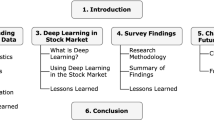Abstract
This paper examines the forecasting performance of three value-at-risk (VaR) models (RiskMetrics, Normal APARCH and Student APARCH). We explore and compare two different possible sources of performance improvements: asymmetry in the conditional variance and fat-tailed distributions. Performance is assessed using a range of measures that address the accuracy and efficiency of each model.
The TAIFEX and SGX-DT Taiwan stock index futures are studied using daily data. Our results suggest that for asset returns which exhibit fatter tails and volatility clustering, like the TAIFEX and SGX-DT futures, the VaR values produced by the Normal APARCH model are preferred at lower confidence levels. However, at high confidence levels, the VaR forecasts obtained by the Student APARCH model are more accurate than those generated using either the RiskMetrics or Normal APARCH models.
Similar content being viewed by others
References
Berndt, E. K., H. B. Hall, R. E. Hall and J. A. Hausman, “Estimation and Inference in Nonlinear Structural Models.” Annals of Economic and Social Measurement 4, 653–666 (1974).
Black, F., “Studies of Stock Market Volatility Changes,” in Proceedings of the American Statistical Association, Business and Economic Statistics Section 177–181 (1976).
Bollerslev, T., “Generalized Autoregressive Conditional Heteroskedasiticity.” Journal of Econometrics 31(3), 307–327 (1986).
Bollerslev, T., “A Conditionally Heteroskedastic Time Series Model for Speculative Prices and Rates of Return.” Review of Economics and Statistics 69, 542–547 (1987).
Cassidy, C. and M. Gizycji, “Measuring Traded Market Risk:Value-at-Risk and Back-Testing Techniques.” Reserve Bank of Australia Research Discussion Paper, No. 9708 (1997).
Christoffersen, P. F., “Evaluating Interval Forecasts.” International Economic Review 39(4), 841–862 (1998).
Diebold, F. X. and J. A. Lopez, “Forecast Evaluation and Combination,” in G. S. Maddala and C. R. Rao (Eds.), Handbook of Statistics, Volume 14: Statistical Method of Finance, Amsterdam: North Holland, 1996, pp. 241–268.
Ding, Z. C., W. J. Granger and R. F. Engle, “A Long Memory Property of Stock Market Returns and a New Model.” Journal of Empirical Finance 1, 83–106 (1993).
Engle, R., “Autoregressive Conditional Heterosedasticity with Estimates of the Variance of United Kingdom Inflation.” Econometrica 50, 987–1007 (1982).
Engle, J. and M. Gizycki, “Conservatism, Accuracy and Efficiency: Comparing Value-at-Risk Models.” Working Paper Series Number wp0002. Australian Prudential Regulation Authority (1999).
French, K., G. Schwert and R. Stambaugh, “Expected Stock Returns and Volatility.” Journal of Financial Economics 19, 3–29 (1987).
Giot, P., “Intraday Value-at-Risk.” CORE DP 2045, Maastricht University METEOR RM/00/030 (2000).
Hendricks, D., “Evaluation of Value-at-Risk Models Using Historical Data.” Federal Reserve Bank of New York, Economic Policy Review, 39–69 (April 1996).
Jorion, P., “Risk and Turnover in the Foreign Exchange Market,” in J. A. Frankel, G. Galli, and A. Giovanni (Eds.), The Microstructure of Foreign Exchange Markets, Chicago: The University of Chicago Press, 1996.
Jorion, P., Value-at-Risk. McGraw-Hill (2000).
Kupiec, P., “Techniques for Verifying the Accuracy of Risk Management Models.” Journal of Derivatives 3, 73–84 (1995).
Lopez, J., “Methods for Evaluating Value-at-Risk Estimates.” Federal Reserve Bank of New York, Research Paper No. 9802 (1998).
Mckenzie, M. and H. Mitchell, “Generalized Asymmetric Power ARCH Modeling of Exchange Rate Volatility.” Applied Financial Economics 12, 555–564 (2002).
Pagan, A. and G. Schwert, “Alternative Models for Conditional Stock Volatility.” Journal of Econometrics 45, 267–290 (1990).
Schwert, W., “Stock Volatility and the Crash of ‘87’.” Review of Financial Studies 3, 77–102 (1990).
Taylor, S., Modeling Financial Time Series. New York: Wiley (1986).
Tse, Y. K. and A. K. C. Tsui, “Conditional Volatility in Foreign Exchange Rates: Evidence for the Malaysian Ringgit and Singapore Dollar.” Pacific-Basin Finance Journal 5, 345–356 (1997).
Van Den Goorbergh, R. and P. Vllar, “Value-at-Risk Analysis of Stock Returns: Historical Simulation, Tail Index Estimation?” De Nederlanse Bank-Staff Report 40 (1999).
Author information
Authors and Affiliations
Rights and permissions
About this article
Cite this article
Huang, Y.C., Lin, BJ. Value-at-Risk Analysis for Taiwan Stock Index Futures: Fat Tails and Conditional Asymmetries in Return Innovations. Review of Quantitative Finance and Accounting 22, 79–95 (2004). https://doi.org/10.1023/B:REQU.0000015851.78720.a9
Issue Date:
DOI: https://doi.org/10.1023/B:REQU.0000015851.78720.a9



